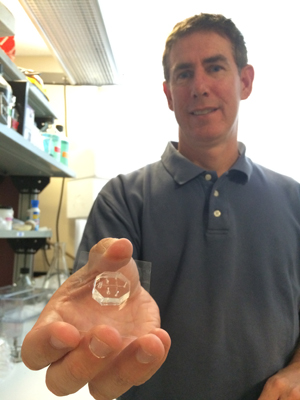Carnegie Mellon, Pitt Researchers Combine Mechanics With Biology To Make Key Discovery About Communication Between Cells
Contacts: Daniel Tkacik / Carnegie Mellon / 412-268-1187 / dtkacik@andrew.cmu.edu
Paul Kovach / University of Pittsburgh / 412-624-0265
 PITTSBURGH—When the body forms new tissues during the healing process, cells must be able to communicate with each other. For years, scientists believed this communication happened primarily through chemical signaling.
PITTSBURGH—When the body forms new tissues during the healing process, cells must be able to communicate with each other. For years, scientists believed this communication happened primarily through chemical signaling.
Now researchers at Carnegie Mellon University and the University of Pittsburgh have found that another dimension — mechanical communication — is equally if not more crucial. The findings, published in this week's issue of the Proceedings of the National Academy of Sciences, could lead to advancements in treatments for birth defects and therapies for cancer patients.
"It's like 19th century scientists discovering that electricity and magnetism were the same force," said Lance Davidson, associate professor of bioengineering at the University of Pittsburgh, who co-led the study. "The key here is using mechanical engineering tools and frameworks to reverse-engineer how these biological systems work, thereby giving us a better chance to develop methods that affect this cellular communication process and potentially treat various diseases related to tissue growth."
Philip LeDuc, the William J. Brown Professor of Mechanical Engineering at Carnegie Mellon who led the study with Davidson, said the research team developed a microfluidic control system that enabled the researchers to alter the mechanical processes at the cellular level. The system delivers chemicals at extremely low flow rates over very small specific areas, such as integrated collections of individual cells. They hypothesized that in addition to using chemical signals to communicate with each other, regenerative cells also used mechanical processes — pushing and pulling on each other — to stimulate and respond.
"In order to identify these mechanical processes, we really had to control small parts of a multi-cellular tissue, which today's technology can finally allow us to do," Davidson explained. For example, a tissue sample two millimeters across may contain up to 8,000 cells. The microfluidic device enables researchers to "touch" as few as three or four and view the mechanical processes using a high resolution laser scanning microscope to view proteins moving in cells.
"We proved that mechanical processes are absolutely important along with chemical," LeDuc said. When the researchers disabled the mechanical connections between the cells using microfluidics, the ability of cells to communicate with each other dropped substantially. Although the cells communicated through chemical signaling as well, the cells' mechanical connections — their ability to push and pull on each other — were dominant in transmitting the signals.
Understanding this additional dimension could impact future research in tissue regeneration, from embryonic development to healing to cancer growth.
"If you are dealing with someone who has a birth defect, and their heart didn't form correctly, the question is how do you target it?" LeDuc asked. "This discovery leads us to believe there is a mechanical way to influence tissue development and one day help the cells better communicate with each other to heal the body."
Other researchers included YongTae Kim, now an assistant professor of biotechnology at Georgia Institute of Technology; Sagar D. Joshi, now a research scientist at Air Liquide; William C. Messner, now the department chair and professor of mechanical engineering at Tufts University School of Engineering; Carnegie Mellon research assistants Melis Hazar Haghgoui and Jiho Song; and Pitt research assistants Timothy R. Jackson and Deepthi Vijayraghavan.
###
Above, Carnegie Mellon's Philip LeDuc holds the microfluidics tool, which enabled him and his group to stimulate a very small region of cells to better understand how the cells were communicating.